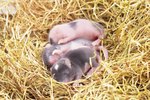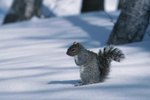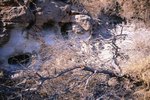Things You'll Need
Heating pad
Cardboard box
Small fleece blanket/throw
3cc and 10cc syringes (without needle)
Esbilac puppy milk replacement powder formula
Liquid thermometer
Temperature gauge
Shredded newspaper
Pedialyte (no flavor)
Pint of heavy whipping cream
Spring thunderstorms and high winds frequently knock baby squirrels from their nests. If you find one of these helpless baby squirrels on the ground, keeping it warm and safe quickly becomes your priority. Once a baby squirrel's temperature drops, its mother cannot find and identify it as her own. This means that it will likely die without assistance from you or another person. If you can't find a local wildlife rehabilitation group to take the baby squirrel, that's OK. You can take care of the squirrel yourself with basic supplies.
Pick up the orphaned squirrel gently using a towel. Place the squirrel in a plastic tub that has a soft fleece and shredded newspaper lining. Place the tub, with 1/8-inch air holes drilled all the way around the top, in a quiet and warm place in your home. Set half of the tub on a heating pad set on low. This will help keep the squirrel warm. Having only half of the tub on the heating pad will allow the squirrel to cool off on the other side if it gets too warm. Make sure the squirrel's temperature is at least 98 degrees before you attempt to feed it.
Hydrate the squirrel with Pedialyte. The squirrel will likely be extremely dehydrated. Before the squirrel can ingest formula, it must be hydrated. Heat the Pedialyte to 98 degrees and slowly feed the squirrel the liquid through the needleless syringe. If you feed it too fast, the baby can inhale the liquid and suffocate.
Check the baby squirrel over for any injuries. If there are any abrasions, clean them thoroughly with warm water, soap and apply antibiotic ointment. If you find serious injuries such as broken limbs, you should contact your veterinarian for assistance.
Feed the baby squirrel formula. The basic formula is 1 cup of water, 1/2 cup of powder Esbilac, and 1/2 cup of heavy whipping cream. Depending on the age and size of squirrel, here's how much to feed it: • Less than one week old with umbilical cord attached: nine feedings a day, 1 cc or 1/4 teaspoon per feeding. • Two to three weeks old: five feedings a day, 1 1/2 cc to start, increased to 3 cc per feeding. • Four to five weeks old: four feedings a day, 3 1/2 cc to start, increased to 5 cc per feeding. • Six to seven weeks old: four feedings a day, 6 cc to start, increased to 9 cc per feeding. • Eight weeks old: two feedings a day, 10 to 14 cc. • At nine weeks old, begin weaning the squirrel off formula with solid pieces of food.
Help the squirrel relieve itself after each feeding. This is what a mama squirrel does and you must, too. Using a dampened cotton swab, stimulate the process by gently rubbing the swab across the baby's genitals. If the baby is not defecating and urinating, contact a veterinarian.
Tips
Seek assistance from your state's department of natural resources and wildlife management officials. They may be able to direct you to a wildlife rehabilitation group that may be able to care for your squirrel and reintroduce it into the wild.
Warnings
Always make sure your squirrel's temperature is between 98 and 102 degrees. Do not feed it if its temperature dips below 98 degrees. Keep baby squirrels away from direct sunlight as their eyes are extremely sensitive to bright light. Don't allow the squirrel's box to reach temperatures in excess of 100 degrees. As baby squirrels grow up, they can be escape artists and also bite or scratch their handlers. Always proceed with caution when handling a wild animal.
References
Photo Credits
-
Ralf Nau/Digital Vision/Getty Images
Writer Bio
A professional journalist, Cheryl Welch has been reporting and editing since 1999. She now leads an award-winning daily newspaper team in Ohio. Welch graduated with Bachelor of Arts degrees in journalism and botany-microbiology.




